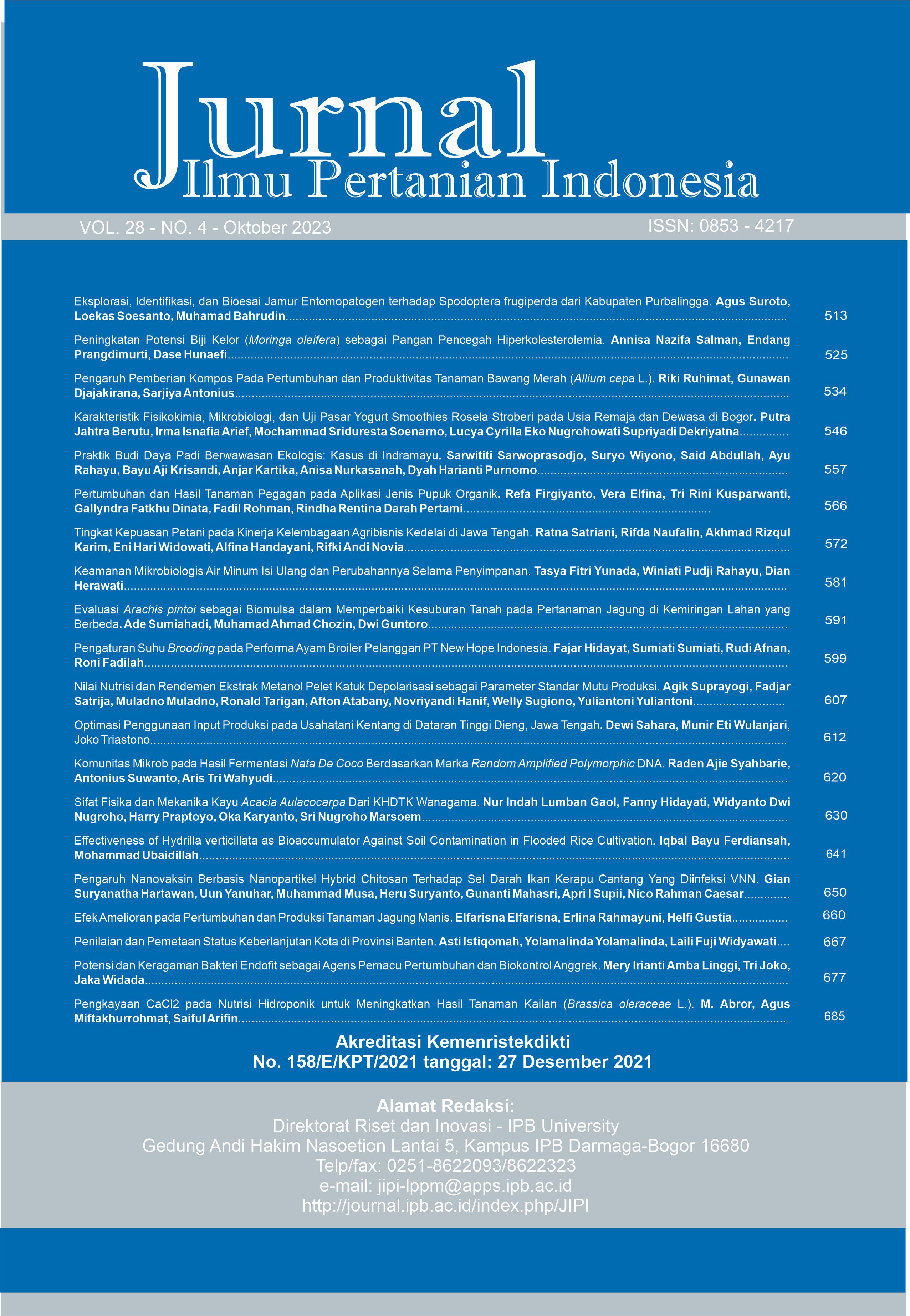Nilai Nutrisi dan Rendemen Ekstrak Metanol Pelet Katuk Depolarisasi sebagai Parameter Standar Mutu Produksi
Abstract
Standardization of the quality of the depolarized katuk pellet production process as a feed additive is very important to maintain product quality. The production process requires dry katuk leaves (DKK) as raw materials which are then processed into depolarized katuk leaves (DKD), and continues in the pelleting process to become depolarized katuk pellets (PKD). Quality standard can be done by measuring the parameters of nutritional value and also the yield of methanol extract. Nutritional values were obtained from the results of proximate analysis, namely the percentage of dry matter, ash content, crude protein, crude fiber, crude fat, beta-N, calcium, phosphorus, and gross energy (Cal/g). Mean while, the yield of methanol extract was obtained by maceration using methanol solvent. This study aims to evaluate the nutritional value and yield of crude methanol extract of katuk leaves (DKK, DKD, PKD) which can be used as a quality assurance standard for the depolarized katuk pellet production process. In general, the nutritional value of DKD and PKD had the same value as that of DKK, except for calcium which was quite high (P<0.05) in DKD and PKD, and the percentage of crude fiber was lower (P<0.05) in PKD compared to DKK and DKD. The percentage of crude fat in pellets (PKD) was higher (P<0.05) when compared to DKK and DKD. The yield of methanol extract was very high (P<0.05) in DKK, compared to DKD and PKD. The nutritional parameters and the yield of the katuk leaf extract can be used as quality assurance standards for the depolarized katuk pellet production process.
Keywords: depolarization, katuk, methanol, nutrition, pellet
Downloads
References
Fachruddin, Suprayogi A, Hanif N. 2017. Pengimbuhan fraksi heksana daun katuk varietas zanzibar dalam pakan meningkatkan produksi susu, tampilan induk dan anak tikus. Jurnal Veteriner. 18(2): 1‒8. https://doi.org/10.19087/jveteriner.2017.18.2.289
Farasyi TR, Budiman H, Akmal M, Melia J, Razali, Novita A, Barus RA, Suprayogi A. 2014. Histological findings in the seminiferous tubule oh male local Kacang goats after supplementation of katuk leaves. Jurnal Kedokteran Hewan. 8(10): 57‒60. https://doi.org/10.21157/j.ked.hewan.v8i1.1261
Ger LP, Chiang AA, Lai RS, Chen SM, Tseng CJ. 1997. Association of Sauropus androgynus and Bronchiolitis obliterans syndrome: A Hospital-based Case-Control Study. American Journal of Epidemiology. 145(9): 842‒849. https://doi.org/10.1093/oxfordjournals.aje.a009178
Letis ZM, Suprayogi A, Ekastuti DR. 2017. Pengimbuhan berbagai sediaan daun katuk pada pakan ayam pedaging menurunkan lemak abdominal, kadar lemak,dan kolesterol daging. Jurnal Veteriner. 18(3): 1‒8. https://doi.org/10.19087/jveteriner.2017.18.3.461
Putranto HD, Hasibuan GP, Yumiati Y, Ginting SM. 2017. Effect of katuk (Sauropus androgynous) powder supplementation on the levels of progesterone (P4) and estradiol-17β (E2) hormones in kacang goat (Capra aegagrus). Nusantara Bioscience. 9(1): 86‒91. https://doi.org/10.13057/nusbiosci/n090115
Snedecor GW, Cochran WC. 1982. Statistical Methods. Edn. Lowa State University Press, Ames, IA, pp.234-235.
Steel RGD dan Torrie JH. 1980. Principles and Procedures of Statistics. A Biometrical Approach. Second edition. New York (US): McGraw Hill Book Co.
Suprayogi A. 2000. Studies on the biological effects of Sauropus androgynus (L,) Merr,: Effects on milk production and the possibilities of induced pulmonary disorder in lactating sheep. Germany (UK): Cuvillier Verlag Göttingen.
Suprayogi A. 2004. Identification of active compounds in Sauropus androgynus leaves. Research-study report, Re-Invitation Program-DAAD Germany (February–April 2004). Institut für Pharmazeutische Biologie, Heinrich-Heine-Universität Düsseldorf, Germany (GB).
Suprayogi A, Latif H, Yudi AH, Ruhyana. 2013. Peningkatan Produksi Susu Sapi Perah di Peternakan Rakyat Melalui Pemberian Katuk-IPB3 sebagai Aditif Pakan. Jurnal Ilmu Pertanian Indonesia. 18(3):140‒143.
Suprayogi A, Kusumorini N, Arita SED. 2015. Fraksi Heksan Daun Katuk Sebagai Obat Untuk Memperbaiki Produksi Susu, Penampilan Induk, dan Anak Tikus. Jurnal Veteriner. 16(1): 88‒95.
Suprayogi A. 2017. Rahasia Daun Katuk (Katuk in Science). Bogor (ID): IPB Press.
Suprayogi A. 2016. Peran Ahli Fisiologi Hewan dalam Mengatisiasi Dampak Pemanasan Global dan Upaya Perbaikan Kesehatan dan Produksi Ternak. Dalam: DA Astuti (Editor). Strategi Peningkatan Produksi Protein Hewani melalui Kajian Biotenologi Terbarukan dan Pendekatan Kesehatan Hewan. Bogor (ID): IPB Press
Suprayogi A, Kartika JG, Santoso E, Ritonga AW. 2022. Substitusi Batang Lunak Pada Produksi Pelet Katuk Depolarisasi Untuk Perbaikan Produktifitas Domba. Jurnal Ilmu Pertanian Indonesia: 27(4): 497‒501. https://doi.org/10.18343/jipi.27.4.497
This journal is published under the terms of the Creative Commons Attribution-NonCommercial 4.0 International License. Authors who publish with this journal agree to the following terms: Authors retain copyright and grant the journal right of first publication with the work simultaneously licensed under a Creative Commons Attribution-NonCommercial 4.0 International License. Attribution — You must give appropriate credit, provide a link to the license, and indicate if changes were made. You may do so in any reasonable manner, but not in any way that suggests the licensor endorses you or your use. NonCommercial — You may not use the material for commercial purposes.























